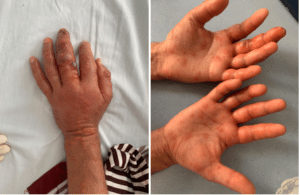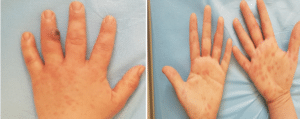Boularbah Siham1*, Douhi Zakia1, Kaoutar Elfid1, Soughi Meryem1, Elloudi Sara1, Baybay Hanane1, Mernissi Fatima Zahra1
1Department of Dermatology, CHU Hassan II, Fez, Morocco
*Correspondence author: Boularbah Siham, Department of Dermatology, CHU Hassan II, Fez, Morocco; Email: [email protected]
Published Date: 17-07-2023
Copyright© 2023 by Siham B, et al. All rights reserved. This is an open access article distributed under the terms of the Creative Commons Attribution License, which permits unrestricted use, distribution, and reproduction in any medium, provided the original author and source are credited.
Clinical Image
ORF nodule is a disease caused by a parapoxvirus ovis with epithelial tropism which is transmitted to humans from sick animals, sheep and goats, suffering from contagious ovine pustular dermatosis ecthyma [1]. Common complications of ORF infection have been reported, including secondary bacterial infection, lymphadenopathy, lymphangitis, more rarely erythema multiforme and bullous pemphigoid [2]. We describe here two cases of ORF nodule with secondary erythema multiforme.
A 35-year-old man with no pathological history presented to the emergency department for a diffuse pruritic papulo-vesicular eruption without mucosal involvement in a context of fever. The interrogation reveals that lesion has been appeared at the level of the 4th finger 2 weeks before and 3 days after contact with a sheep that seemed to be in good health.
On examination, there was a purplish and eroded nodule taking on the dorsal surface of his right middle finger (Fig. 1), cockades and pseudo-cockades scattered all over the body with an acral predominance without involvement of the mucous membranes (Fig. 1). At the level of the internal face of the left arm, we noted metameric vesicles arranged on the arm. The diagnosis of ORF and erythema multiforme associated with shingles on the left arm was retained. A biological assessment of immunosuppression was carried out, returning without particularity. The patient was put on injectable antibiotic therapy, curative antiviral and local care, the evolution was marked by a good improvement.
A 22-year-old patient, with no notable pathological history, initially presented for consultation for an erythematous nodular lesion located on the outer surface of the right wrist evolving for 1 week (Fig. 2), after trauma by a knife during manipulation a sheep’s head, without other associated signs. The dermoscopic examination shows a central ulceration, yellowish crust, partially surrounded by a white area without structure then an erythematous halo in the periphery with light red blood cells, the diagnosis of nodule of ORF was retained, the patient was treated with local care. One week later, the patient returned to the emergency department for infiltrated erythematous lesions at the acral level without mucosal lesions (Fig. 2) with the persistence of nodules of ORF. The diagnosis of erythema multiforme complicating an ORF nodule was retained. The patient was put under local care, analgesic and antihistamine with oral antibiotic therapy. When followed up in a week, the rash had completely resolved.
ORF or contagious ecthyma is a minor zoonosis, occurring in the form of a rare skin infection in humans, linked to the ORF virus of the poxviridae family, of the Parapoxvirus genus and of the DNA virus group [2,3]. Small ruminants, especially sheep and goats, are the main reservoirs. It is commonly reported after Islamic Aid El Adha (the festival of sacrifice) during which sheep are handled with bare hands for slaughter. Transmission to humans occurs directly through contact with injured skin or mucous membranes. Neither of the two patients described in this report recalled seeing skin lesions on the animal [4]. This could have been the case if this animal had small or nearly healed infectious lesions. The cases of ORF nodules described during immunosuppression are observed in transplant patients, having a blood disease or another pathology under an immunosuppressant, this immunosuppression generally promotes the development of giant or disseminated forms of Orf nodule [5]. Diagnosis is primarily based on animal contact history and clinical findings. Molecular tests are used to confirm the clinical diagnosis.
ORF can be complicated by bacterial superinfection, erysipelas, lymphadenopathy, lymphangitis, recurrent lesions. The Erythema Multiforme (EM) reaction, as presented in these cases, is a rare complication of parapoxvirus infections.
Erythema multiforme is characterized by acral lesions in roundels with or without involvement of the mucous membranes. It is a pathology of delayed hypersensitivity most often post-infectious herpetic, and can also be secondary to other causes including Mycoplasma pneumoniae and certain drugs. Viral triggers of ME include herpes simplex virus, Epstein-Barr virus, adenoviruses, enteroviruses, hepatitis viruses, there are only a few reports describing ME reactions in parapoxvirus virus or ORF nodule. In most cases, it appears 14 days after the typical ORF skin lesion and disappears in about 1 week. It is most often moderate without attack of the mucous membranes and without deterioration of the general state, like the clinical form of our patients. The mechanism of EM induction by ORF virus is not well understood. The virus produces multiple immunomodulatory virulence factors such as mammalian vascular endothelial growth factor that interfere with the host’s inflammatory and immune response.
In our two patients, and given the absence of other etiological factors and the notion of contact with sheep, we incriminated the parapoxvirus in the occurrence of erythema multiforme. Further study is needed on the identification of viral and host virulence factors contributing to the occurrence of hypersensitivity reactions in humans after ORF nodule.

Figure 1: (a) Nodular lesion of ecthyma contagiosum (observation 1, right); (b) Erythema multiforme of extremities (observation 1, left).

Figure 2: (a) Nodular ecthyma lesion contagiosum (observation 2, right); (b) Erythema multiforme of extremities (observation 2, left).
Keywords: ORF Infection; Erythema Multiforme; Hepatitis Viruses; Antibiotic Therapy
Consent
The examination of the patient was conducted according to the principles of the Declaration of Helsinki. The authors certify that they have obtained all appropriate patient consent forms, in which the patients gave their consent for images and other clinical information to be included in the journal. The patients understand that their names and initials will not be published and due effort will be made to conceal their identity, but that anonymity cannot be guaranteed.
Conflict of Interest
The authors have no conflict of interest to declare.
References
- Joseph VC, Amor K. ORF virus infection in humans: a review with a focus on advances in diagnosis and treatment. J Drugs Dermatol. 2017, 16:684-9.
- HAM Al-Bayati. Assessment of contagious ecthyma virus in camels of wasit province, Iraq. Arch Razi Ins. 2022;77:565-71.
- Joseph RH, Haddad FA, Matthews AL, Maroufi A, Monroe B, Reynolds M. Erythema multiforme after ORF virus infection: a report of two cases and literature review. Epidemiol Infect. 2015;143:385-90.
- Angella LC, Gustavo C, Nicole K, Isabel CMD, Esperanza PPMD, Antonio T MD. Erythema multiforme after ORF virus infection. Pediatr Dermatol. 2018;35(4):e237-8.
- Hayati D, Gokcen D, Mehmet D. An overview of ORF virus infection in humans and animals. Recent Pat Antiinfect Drug Discov. 2017;12:21-30.
- Tamer F, Yuksel ME. The spectacular presentation of ORF disease. Our Dermatol Online. 2018;9:152-3.
Article Type
Clinical Image
Publication History
Received Date: 21-06-2023
Accepted Date: 10-07-2023
Published Date: 17-07-2023
Copyright© 2023 by Siham B, et al. All rights reserved. This is an open access article distributed under the terms of the Creative Commons Attribution License, which permits unrestricted use, distribution, and reproduction in any medium, provided the original author and source are credited.
Citation: Siham B, et al. ORF Nodule Complicated by Erythema Multiforme: About 2 Cases. J Dermatol Res. 2023;4(2):1-2.

Figure 1: (a) Nodular lesion of ecthyma contagiosum (observation 1, right); (b) Erythema multiforme of extremities (observation 1, left).

Figure 2: (a) Nodular ecthyma lesion contagiosum (observation 2, right); (b) Erythema multiforme of extremities (observation 2, left).


